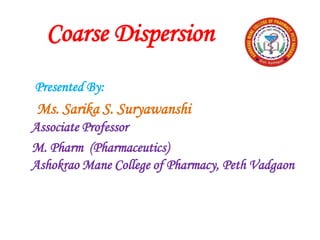Coarse dispersion refers to heterogeneous systems containing particles larger than colloids suspended in a continuous phase. Coarse suspensions have particle sizes between 1-100 μm. The rate of sedimentation depends on factors like particle size, density, and viscosity according to Stokes' law. Formulating a suspension as either flocculated or deflocculated impacts sedimentation properties. Flocculated suspensions have loosely aggregated particles that sediment rapidly but redisperse easily. Deflocculated suspensions have individual particles that sediment slowly to avoid cracking but are harder to redisperse. Controlling interparticle interactions and surface energies can optimize a suspension's physical stability.






























